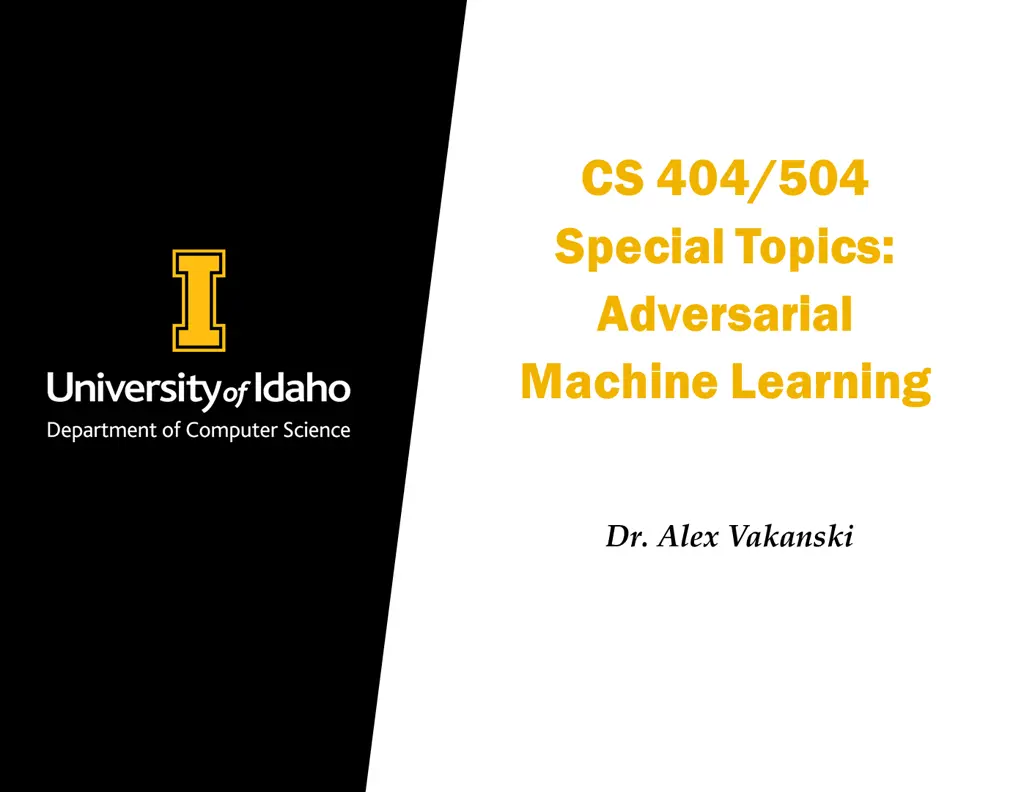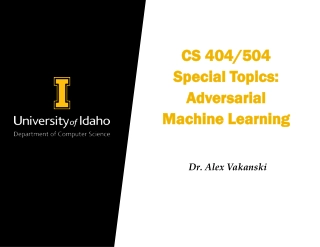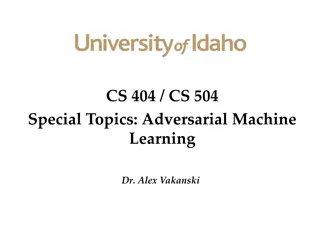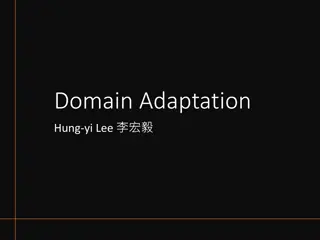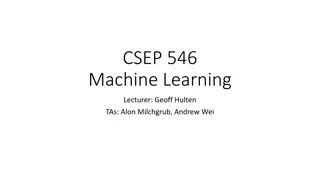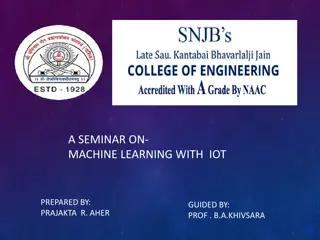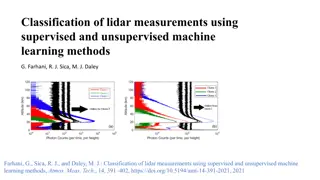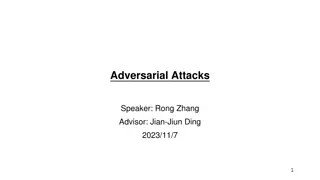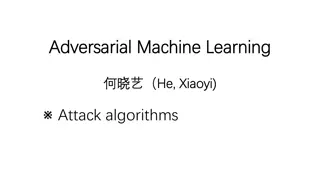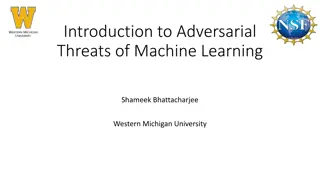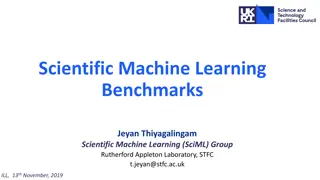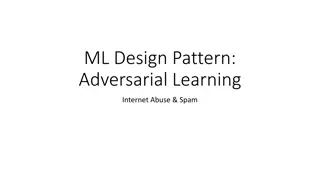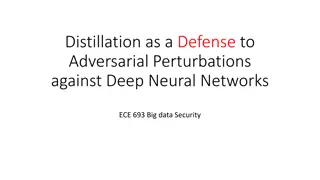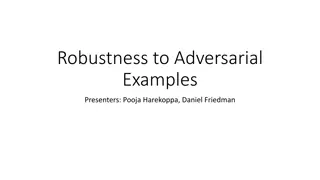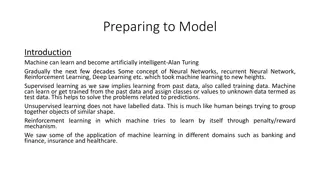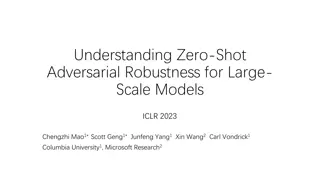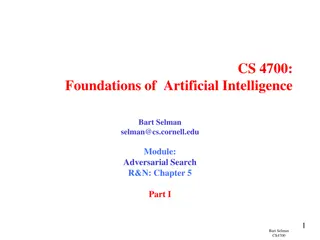Adversarial Machine Learning
Evasion attacks on black-box machine learning models, including query-based attacks, transfer-based attacks, and zero queries attacks. Explore various attack methods and their effectiveness against different defenses.
Download Presentation

Please find below an Image/Link to download the presentation.
The content on the website is provided AS IS for your information and personal use only. It may not be sold, licensed, or shared on other websites without obtaining consent from the author.If you encounter any issues during the download, it is possible that the publisher has removed the file from their server.
You are allowed to download the files provided on this website for personal or commercial use, subject to the condition that they are used lawfully. All files are the property of their respective owners.
The content on the website is provided AS IS for your information and personal use only. It may not be sold, licensed, or shared on other websites without obtaining consent from the author.
E N D
Presentation Transcript
CS 404/504 CS 404/504 Special Topics: Special Topics: Adversarial Adversarial Machine Learning Machine Learning Dr. Alex Vakanski
CS 404/504, Spring 2023 Lecture 5 Lecture 5 Evasion Attacks against Black-box Machine Learning Models 2
CS 404/504, Spring 2023 Lecture Outline Bhagoji et al. (2017) Exploring the Space of Black-box Attacks on Deep Neural Networks Brendel et al. (2018) Decision-Based Adversarial Attacks: Reliable Attacks Against Black-Box Machine Learning Models Transferability in Adversarial Machine Learning Substitute model attack Ensemble of local models attack Other black-box evasion attacks HopSkipJump attack ZOO attack Simple black-box attack 3
CS 404/504, Spring 2023 Evasion Attacks against Black-box Models Black-box Evasion Attacks Black-box adversarial attacks can be classified into two categories: Query-based attacks o The adversary queries the model and creates adversarial examples by using the provided information to queries o The queried model can provide: Output class probabilities (i.e., confidence scores per class) used with score-based attacks Output class, used with decision-based attacks Transfer-based attacks (or transferability attacks) o The adversary does not query the model o The adversary trains its own substitute/surrogate local model, and transfers the adversarial examples to the target model o This type of approaches are also referred to as zero queries attacks 4
CS 404/504, Spring 2023 Gradient Estimation Attack Gradient Estimation Attack Bhagoji, He, Li, Song (2017) Exploring the Space of Black-box Attacks on Deep Neural Networks The paper introduces an approach known as Gradient Estimation attack Score-based black-box attack Based on query access to the model s class probabilities Both targeted and untargeted attacks are achieved Validated on MNIST and CIFAR-10 datasets The attack is also evaluated on real-world models hosted by Clarifai Advantages: Outperformed other black-box attacks Performance results are comparable to white-box attacks Good results against adversarial defenses 5
CS 404/504, Spring 2023 Gradient Estimation Attack Gradient Estimation Attack Gradient Estimation (GE) approach Uses queries to directly estimate the gradient and carry out black-box attacks The output to a query is the vector of class probabilities ??(?) (i.e., confidence scores per class) for an input x o The logits can also be recovered from the probabilities, by taking log ??? The authors employed the method of finite differences for gradient estimation Let ?(?) is a function whose gradient needs to be estimated Finite difference (FD) estimation of the gradient of g with respect to input x is given by is a parameter that controls the estimation accuracy (selected 0.01 or 1) ??are basis vectors such that ??is 1 only for the ithcomponent and 0 everywhere else If the gradient exists, then the finite differences method can calculate an approximation of the gradient: lim ? 0FD??(?), ???(?) 6
CS 404/504, Spring 2023 Gradient Estimation Attack Gradient Estimation Attack Approximate FGSM attack with finite difference GE method Gradient of a model f is taken with respect to the cross-entropy loss ??,? o For input x with true class label y, the loss is ??log (?) = (?) o Recall that the derivative of a log function is ? 1 ?and thus ? ??log ? = (?) Therefore, the gradient of the loss function ??,? with respect to the input x is An untargeted FGSM adversarial sample can be generated by using the FD estimate of the gradient ???? ?(?), i.e., Similarly, a targeted FGSM adversarial sample with class T can be found by using 7
CS 404/504, Spring 2023 Gradient Estimation Attack Gradient Estimation Attack Approximate C-W attack with finite difference GE method Carlini & Wagner attack uses a loss function based on the logits values ? Logits values ? can be computed by taking the logarithm of the softmax probabilities, up to an additive constant For an untargeted C-W attack, the loss is the difference between the logits for the true class y and the second-most-likely class y , i.e., ? ? + ?? ? ? + ?? o Since the loss is the difference of logits, the additive constant is canceled o By using FD approximation of the gradient, it is obtained For a targeted C-W attack, the adversarial sample is 8
CS 404/504, Spring 2023 Gradient Estimation Attack Gradient Estimation Attack Iterative FGSM attack with finite difference GE method This is similar to the Projected Gradient Descent attack, which uses several iterations of the FGSM attack and achieves higher success rate than the single step FGSM attack An iterative FD attack with ? + 1 iterations using the cross-entropy loss is ??adv ? FD ??adv ?? ,? ? ?+1= ?adv ? ?adv + ? sign ??adv ? ?? Iterative C-W attack is also applied in a similar manner by modifying the single- step approach presented on the previous page ?+1= ?adv ? ?adv + ? sign sign FD ? ?? ? ??,? 9
CS 404/504, Spring 2023 Experimental Validation Gradient Estimation Attack Validation of non-targeted black-box attacks using Gradient Estimation with FD The table presents the success rate and average distortion (in parenthesis) Baseline methods: o D. of M. Difference of Means attack, uses the mean difference between the true class and the target class as added perturbation o Rand. Random perturbation by adding random noise from a distribution (e.g., Gaussian) xent is for cross-entropy loss, logit is C-W logits loss, I is iterative MNIST with ? constraint of = 0.3, and CIFAR-10 with ? constraint of = 8 Iterative C-W attack (IFD-logit) produced best results 10
CS 404/504, Spring 2023 Experimental Validation Gradient Estimation Attack Validation of targeted black-box attacks using Gradient Estimation with FD Iterative FGSM (IFD-xent) attack produced best results on MNIST Iterative C-W (IFD-logit) attack produced best results on CIFAR-10 11
CS 404/504, Spring 2023 Query Reduction Gradient Estimation Attack Shortcoming of the proposed approach: Requires ?(?) queries per input, where d is the dimension of the input (e.g., number of pixels in images) The presented FD approximation required 2 ? queries The authors propose two approaches for reducing the number of queries Random grouping o The gradient is estimated only for a random group of selected pixels, instead of estimating the gradient per each pixel PCA (Principal Component Analysis) o Compute the gradient only along a number of principal component vectors 12
CS 404/504, Spring 2023 Query Reduction Gradient Estimation Attack Validation of the methods for query reduction For random grouping, the success rate decreases with decreasing the group size (left figure) o I.e., using only 3 group of pixels to estimate the gradient is less efficient than using 112 groups of pixels For PCA, the success rate decreases as the number of PC is decreased (middle and right figure) o The success rate is still high for smaller number of PC 13
CS 404/504, Spring 2023 Adversarial Samples Gradient Estimation Attack Non-targeted adversarial samples WB-IFGS white-box iterative FGSM attack IFD-logit black-box iterative C&W attack (logit loss) IGE-QR-PCA - black-box Iterative Gradient Estimation with Query Reduction using PCA 14
CS 404/504, Spring 2023 Defense Evaluation Gradient Estimation Attack Evaluation of adversarial samples against three adversarial defenses Adversarial training (Szagedy et al, 2014): Adv column in the table Ensemble adversarial training (Tramer et al, 2017): Adv-Ens column Iterative adversarial training (Madry et al, 2017): Adv-Iter column The accuracy is almost the same as for benign (non-attacked) images (first column in the table) 15
CS 404/504, Spring 2023 Attacks on Real Models Gradient Estimation Attack Attacks on two real-world models hosted by Clarifai Not Safe For Work (NSFW) model o Two categories: safe , not safe Content Moderation model o Five categories: safe , suggestive , explicit , drug, and gore o Example: an adversary could upload violent adversarially-modified images, which may be marked incorrectly as safe by the Content Moderation model Original image Class: drug Confidence: 0.99 Adversarial image Class: safe Confidence: 0.96 16
CS 404/504, Spring 2023 Boundary Attack Boundary Attack Brendel, Rauber, and Bethge (2018) Decision-Based Adversarial Attacks: Reliable Attacks Against Black-Box Machine Learning Models A query-based black-box attack called Boundary Attack This is a decision-based attack, i.e., it requires only queries of the output class, and not the logits or output probabilities Can perform both non-targeted and targeted attacks Advantage: Finds low-perturbation images only by using the output class information Relevant to real-world application, where access to the model may not be possible Disadvantage: Requires many iterations to converge (i.e., large number of queries) Validation on MNIST, CIFAR-10, and ImageNet And, on real-world applied models 17
CS 404/504, Spring 2023 Boundary Attack Boundary Attack Boundary Attack intuition The starting image is drawn from a uniform random distribution (random noise), and is adversarial (i.e., different than the true label) Iteratively reduce the L2distance to the original image by adding small perturbations Walk along the boundary between the adversarial and the non-adversarial region, but stay in the adversarial region o I.e., whenever the added perturbation results in correct classification, reject those samples (a.k.a., sample rejection) When the distance to the original image cannot be further reduced, or when the number of set iteration steps is reached, stop 18
CS 404/504, Spring 2023 Boundary Attack Algorithm Boundary Attack Boundary Attack algorithm The initial image ?0is sampled from a uniform distribution ?(0,1) The adversarially perturbed image at the kthstep is denoted ?? Adversarial criterion ?( ) is: misclassification o I.e., different class than the true class (non-targeted attack), or the target class (targeted attack) Decision of model ?( ) is: L2distance between the perturbed and the original image The proposal distribution for the perturbation ??is discussed on next page 19
CS 404/504, Spring 2023 Boundary Attack Boundary Attack For the proposal distribution ? ?? 1of the perturbation ??, the authors used a Gaussian distribution ?(0,1) This perturbation is denoted as #1 random orthogonal step in the figure below Next, it is ensured that the proposed adversarial sample is a regular image with all pixels clipped in the range [0,1] ? 0,1 ? ?+ ?? ?? It is also ensured that the perturbation ??is within aball with radius ? around the original image ? ( i.e., the added perturbation at each step is limited) ?? 2= ? ? ?, ?? 1 Afterward, a small movement ? (#2 step in the image) is made toward the original image ?, so that the distance to ? is iteratively reduced ? ?, ?? 1+ ?? ? ?, ?? 1= ?? ?, ?? 1 20
CS 404/504, Spring 2023 Boundary Attack Boundary Attack The two parameters ? (random orthogonal step) and ? (step toward the original image) are adjusted dynamically The parameters ? is adjusted to that that about 50% of the perturbations are adversarial If this ratio is much lower than 50%, the step size ? is reduced In the opposite case, ? is increased Next, a small step ? toward the original image is applied If the success rate is too small, ? is decreased If it is too large, ? is increased The attack is converged whenever ? converges to zero I.e., the L2distance to the original image can not be reduced anymore 21
CS 404/504, Spring 2023 Adversarial Examples Boundary Attack Example of an untargeted attack Starts from upper left and proceeds to the lower right image Above: total number of calls, i.e., queries Below: L2distance between the attacked image and the original image The original image used for the attack is shown in the lower right corner 22
CS 404/504, Spring 2023 Adversarial Examples Boundary Attack Example of a targeted attack Original class: tiger cat (lower right image) Target class: Dalmatian dog (upper left image) Goal: create an adversarial image that is perceptually close (in L2distance) to a given image of a tiger cat (lower right), but is classified as a Dalmatian dog The algorithm is initialized from a sample image of the target class that is correctly classified by the model (upper left image of Dalmatian dog) 23
CS 404/504, Spring 2023 Experimental Validation Boundary Attack Comparison to FGSM, DeepFool, and Carlini-Wagner non-targeted attacks Presented values: median L2distance to the original images The added perturbations by the Boundary Attack are comparable and not much larger than the perturbation by white box models Comparison to Carlini-Wagner targeted attack 24
CS 404/504, Spring 2023 Real-World Applications Boundary Attack In many real-world applications, the attacker has no access to the model or the training data, but can only observe the final decision E.g., security systems (face identification), autonomous cars, speech recognition (Alexa, Cortana) The authors applied Boundary Attack to two models by Clarifai For identifying over 500 brand names in natural images For identifying over 10,000 celebrities 25
CS 404/504, Spring 2023 Transfer-based Attacks Transfer-based Attacks Transfer-based attacks (or transferability attacks) The adversary does not query the model Reviewed attacks Substitute model attack (a.k.a. surrogate local model attack) o Train a substitute model, and transfer the generated adversarial samples to the target model Ensemble of local models attack o Use an ensemble of local models for generating adversarial examples 26
CS 404/504, Spring 2023 Substitute Model Attack Substitute Model Attack Substitute model attack (or surrogate local model attack) Papernot et al. (2016) Transferability in Machine Learning: from Phenomena to Black- Box Attacks using Adversarial Samples Uses FGSM for attacking a substitute model, and afterward transfer the generated adversarial samples to the target model Transferability between the following ML models is explored: Deep neural networks (DNNs) Logistic regression (LR) Support vector machines (SVM) Decision trees (DT) k-Nearest neighbors (kNN) Ensembles (Ens) Evaluated on MNIST 27
CS 404/504, Spring 2023 Substitute Model Attack Substitute Model Attack Intra-technique variability Five models (A,B,C,D,E) of the same ML method are trained and transferred o E.g., adversarial examples created by one DNN are transferred to the other DNNs Model accuracies (left), and attack success rate for DNNs (right) 28
CS 404/504, Spring 2023 Substitute Model Attack Substitute Model Attack Intra-technique variability Attack success rates for SVM, DT, and kNN are shown below, when transferring examples between the models A, B, C, D, and E of the same ML method Differentiable models like DNNs and LR are more vulnerable to intra-technique transferability than non-differentiable models like SVMs, DTs, and kNNs 29
CS 404/504, Spring 2023 Substitute Model Attack Substitute Model Attack Cross-technique variability Transfer adversarial samples from one ML method to the other ML methods o E.g., adversarial examples created by DNN transferred to other ML models (the first row) The most vulnerable model is DT: misclassification rates from 79.31% to 89.29% The most resilient is DNN (first column): misclassification between 0.82% and 38.27% 30
CS 404/504, Spring 2023 Ensemble of Local Models Attack Ensemble of Local Models Attack Ensemble of local models attack Liu et al. (2017) Delving into Transferable Adversarial Examples and Black-box Attacks Observations regarding transferability Transferable non-targeted adversarial examples are easy to find However, targeted adversarial examples rarely transfer with their target labels The proposed approach allows transferring targeted adversarial examples 31
CS 404/504, Spring 2023 Ensemble of Local Models Attack Ensemble of Local Models Attack On ImageNet, targeted examples do not transfer across models Only a small percentage of adversarial images retain the target label when transferred to other models (between 1% and 4%, off diagonal values in the table) RMSD is the average perturbation of the used adversarial images On the other hand, untargeted examples transfer well 32
CS 404/504, Spring 2023 Ensemble of Local Models Attack Ensemble of Local Models Attack Hypothesis: if an adversarial image remains adversarial for multiple models, it is more likely to transfer to other models as well Approach: solve the following optimization problem (for targeted attack): The problem is similar to C&W ? is a clean image ? is an adversarial image ? ?,? is distance function ?1,?2, , ??are white-box models in the ensemble ?1,?2, , ??are the ensemble weights log ?1?1 ?? is the cross-entropy loss between the prediction by model ?1and the one-hot vector for the target class ?? 33
CS 404/504, Spring 2023 Targeted Attack Evaluation Ensemble of Local Models Attack Targeted attack using the ensemble attack E.g., the first row shows the attack success rate when an ensemble of 4 models (ResNet-101, ResNet-50.VGG-16, and GoogLeNet) is trained, and the samples are transferred to ResNet-152 o The success rate of transferred attack is 38% 34
CS 404/504, Spring 2023 Non-targeted Attack Evaluation Ensemble of Local Models Attack Non-targeted ensemble attack results Using an ensemble of four models, the success rate is very high for non-targeted attack 35
CS 404/504, Spring 2023 HopSkipJump Attack HopSkipJump Attack HopSkipJump Attack Chen and Jordan (2019) HopSkipJumpAttack: A Query-efficient Decision-based Adversarial Attack This attack is an extension of the Boundary Attack I.e., it is a decision-based attack, and therefore has access only to the predicted output class o HopSkipJump Attack requires significantly fewer queries than the Boundary Attack It includes both untargeted and targeted attacks Proposes a a novel approach for estimation of the gradient direction along the decision boundary 36
CS 404/504, Spring 2023 HopSkipJump Attack HopSkipJump Attack Approach: 1. Start from an adversarial image ?? 2. Perform a binary search to the original image x* to find the boundary (left figure) 3. Estimate the gradient direction at the boundary point ??(second figure from left) 4. Perform a step-size search, and update to the next image ??+1 5. Search again for the next boundary point ??+1(right figure) 6. Repeat until the closest adversarial image to the original image x* is found 37
CS 404/504, Spring 2023 HopSkipJump Attack HopSkipJump Attack Experimental evaluation Comparison to Boundary attack and Opt attack on CIFAR-10 HopSkipJump (blue curve) achieves lower 2perturbation using fewer queries 38
CS 404/504, Spring 2023 HopSkipJump Attack HopSkipJump Attack Untargeted attack 2ndto 9th columns: images at 100, 200, 500, 1K, 2K, 5K, 10K, 25K queries The original image for the attack is shown on the right Targeted attack 39
CS 404/504, Spring 2023 ZOO Attack ZOO Attack ZOO attack Chen (2017) Zoo: Zeroth-order optimization based black-box attacks to deep neural networks without training substitute models Zeroth-order optimization refers to optimization based on access to the function values ?(?) only As opposed to first-order optimization via the gradient ??(?) E.g., score-based and decision-based black-box approaches are zeroth-order optimization methods, as they don t require the gradient information ZOO attack has similarities with the Gradient Estimation Attack It is a score-based black-box version of the Carlini-Wagner attack 40
CS 404/504, Spring 2023 Adversarial Attack ZOO Attack Recall again that the Gradient Estimation attack uses the finite difference approach to approximate the gradient as ? = ??? ? ? ?+ ? ? 2 E.g., if the intensity of a pixel ??is 150, and = 10, then we will query the model to give us the predictions for ? 150 + 10 = f 160 and for ? 150 10 = f 140 , so we can estimate the gradient ??= ???? ? for the pixel ?? We need to do 2 queries for each pixel, and for an images with 28 28 pixels = 784 pixels, we need to do 2 784 = 1,568 queries to estimate the gradient ZOO attack solves an optimization, similar to C&W targeted white-box attack 2+ ? ? ?? ? ?? minimize ? ?? 2 subject to ? 0,1 ZOO solves the optimization problem with the FD estimated loss based on: 2+ ? ?? ? ?? ? ??, subject to ? 0,1 minimize ? ?? 2 Adam optimization is used to solve the problem 41
CS 404/504, Spring 2023 Adam Optimization Attack ZOO Attack Algorithm for the ZOO attack using Adam optimization 42
CS 404/504, Spring 2023 Newton Optimization Attack ZOO Attack The paper proposed one more similar approach, that instead of Adam optimization uses Newton optimization method Newton optimization method finds a minimum of ?(?) by performing the following ? (??) ? (??) The approximation of the Hessian matrix of the model is estimated based on ?2 ??2? ? ? ?+ ?? ? +? ? iterations: ??+1= ?? ? = ?? ? ?? ? ??) If ? > ?, then the loss function is convex, update is based on ? ? (i.e., ?? If ? ?, then the loss function is concave, update is based only on the gradient ? (i.e., ?? ? ??) Convex Concave ?2? ? ??2 ?2? ? ??2 < 0 > 0 43
CS 404/504, Spring 2023 Newton Optimization Attack ZOO Attack Algorithm for the ZOO attack with Newton optimization 44
CS 404/504, Spring 2023 Experimental Evaluation ZOO Attack On MNIST and Cifar-10, ZOO attacks achieved almost 100% success rate The added ?2perturbations are comparable to C&W white-box attack As expected, the time for generating adversarial samples is longer than white-box attacks 45
CS 404/504, Spring 2023 Experimental Evaluation ZOO Attack Comparison between C&W white-box (left) and ZOO attack (right) 46
CS 404/504, Spring 2023 Queries Reduction ZOO Attack The authors proposed techniques to reduce the number of queries Note that for 28 28 pixels, we need 2 784 = 1,568 queries to estimate the gradient Recall that PCA and random sets of pixels were used in Gradient Estimation attack The proposed approach starts with reduced resolution, and the resolution is progressively increased (referred to as hierarchical attack) E.g., an original image of a size 299 299 pixels is used Divide the image into 8 8 regions o Make only 64 queries to estimate the gradients o Optimize until the loss start decreasing Increase to 16 16 regions o Make queries and optimize until the loss start decreasing Increase to 32 32 regions o Make queries and optimize until the loss start decreasing Repeat until the attack is successful 47
CS 404/504, Spring 2023 Queries Reduction ZOO Attack Another technique for query reduction is based on importance sampling o Estimate the gradient only for the most important regions in an image Upper figures show the gradient for the Red, Green, and Blue channels E.g., corner pixels are less important for this image, and the changes in R are more important than G and B channels Lower figures shows the most important pixels for R, G, B channels, that are queried first 48
CS 404/504, Spring 2023 Experimental Evaluation ZOO Attack ImageNet untargeted attack Recall that there are 1,000 classes in ImageNet InceptionV3 model used ZOO attack required about 192,000 queries per image, 20 minutes per image The success rate is lower than C&W white-box attack, but is still high 49
CS 404/504, Spring 2023 Examples ZOO Attack Targeted attack The added perturbations are imperceptible 50
